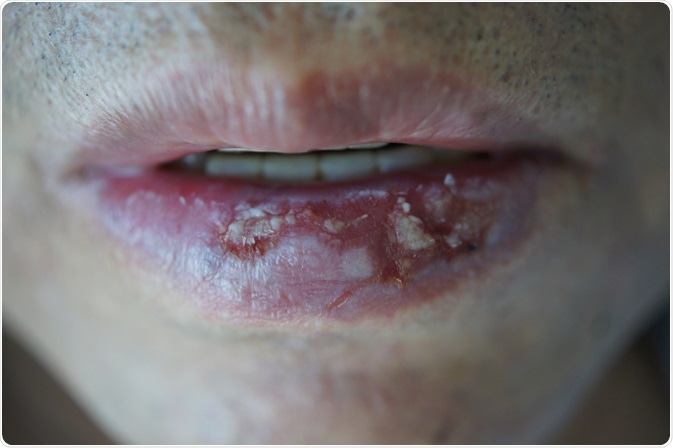Actinic cheilitis (AC) is a common disease characterized by grayish-white areas of discoloration on the lower lip. AC should be effectively diagnosed and treated carefully, as it may undergo cancerous transformation.

Image Credit: OlverCh / Shutterstock.com
Diagnosis
The diagnosis of AC is based on the clinical and histopathological appearance of the lips, which is complemented by obtaining a relevant medical and family history, a patch test, biopsy tests, visual observational, videoroscopy, and reflectance confocal microscopy (RCM).
The presence of AC-associated systemic conditions such as lichen planus, atopic dermatitis, lupus, and nutritional deficiencies should be noted. Furthermore, if present, the condition of the AC lesion, whether acute, chronic, or carcinomatous, should also be recorded.
AC is primarily diagnosed through an allergic reaction that is produced during a patch test. The patch test and its readings are implemented in consonance with the standard North American Contact Dermatitis Group (NACDG) training. According to NACDG, a patch which is precoated with 65 allergens, or allergy-causing materials, is made to come in contact with the lips. Among the 65 allergens, the patient’s lip will be hypersensitive to at least one patch allergen, which through serial interpretation is recorded as the cause of allergic AC.
Once a patch test has been completed and the reaction is recorded, the definitive diagnosis of AC will require a biopsy test. A biopsy test involves the removal of a small area of infected lip tissue for the examination of either the presence or absence of AC.
Videoroscopy is a diagnostic tool used to select the biopsy area for AC diagnosis, on the basis of examination of images of the lower lip under magnification and sufficient lighting. This tool is also employed for the follow-up of treated patients, as videoroscopy saves the AC images at each visit, which helps to compare the effectiveness of treatment and the changes at different stages of treatment.
RCM is a non-intrusive imaging tool that has been recently used in the diagnosis of AC. To this end, RCM is employed for obtaining baseline findings, following up a biopsy test, and to measure tissue damage and treatment efficacy after certain treatments for AC. A recent study used RCM for AC diagnosis and reported that 80% of AC was correctly determined and an accuracy of 100% was achieved in the identification of benign lesions.
Treatment options
Many treatments are available to achieve a complete cure of AC lesions and for the management of the precancerous stage of AC. Each of these treatment options requires the patient to undergo clinical and histopathological evaluation after several weeks of therapy in order to assess the efficacy of the treatment. Regular follow-up after the completion of treatment is also essential.
Cryotherapy
Cryotherapy utilizes extreme cold temperatures to treat the AC lesion. Cryotherapy specializes in treating localized cancers, which includes the carcinogenic stage of AC. The duration of exposure of the affected area to the colder temperature depends on the level of damage sought to be induced. Some side effects may occur, including numbness and redness of lips.
Vermilionectomy
A vermilionectomy is a surgical procedure for precancerous lesions of the lips and involves the excision of the lip layer under total anesthesia. In the cancerous stage of AC, this treatment is often performed with subsequent reconstructive procedures to ensure a positive aesthetic outcome.
Laser therapy
Laser therapy employs a particular wavelength of light that interacts with the lip tissue to treat AC. Carbon dioxide and Erbium: Yttrium-aluminum garnet (Er:YAG) lasers are commonly used in this treatment. The individual use of these lasers has been found to be more effective in this treatment. The cosmetic results are excellent over the short term, with only a low risk of chronic scarring following Er:YAG laser treatment.
Alternative Treatments
Several alternative treatments are offered to patients who refuse or are unfit for surgical procedures, which include photodynamic therapy (PDT) and topical pharmacotherapy.
PDT
PDT employs photosensitizing drugs such as methylaminoixypentanoate, flurouracil, or imiquinol to make the abnormal cells of the lesion susceptible to light-induced damage. These drugs are effective only in the presence of a specific wavelength of light, which differs from one to another.
Anesthesia is administered for the control of local pain during the treatment. Sometimes, natural daylight is the active agent when certain photosensitive drugs are used, such as methylaminolevulonic acid.
Researchers have used methylaminoxypentanoate along with red light for the treatment of AC. In most cases, two sessions are conducted with a one-week interval between them. Complete cure and partial cure occurred in 47% of patients each in one study.
Comparatively, PDT administered with methyl-aminolevulonic acid is effective in the treatment of AC, as it significantly reduces the extent and severity of the lesions. This drug is topically applied in the affected area, which is then exposed to red light with a wavelength of 634 nanometers (nm) after 3 hrs. However, many lesions continue to persist after the treatment.
Topical pharmacotherapy
Both imiquimod and fluorouracil are antineoplastic drugs that are effective in treating the carcinogenic stage of AC. These drugs are applied on the lips in a cream formulation, and the application is continued for up to 6 weeks to produce the optimal effect. Imiquimod has been found to be helpful in managing dysplastic lip lesions and is used after PDT for efficient results.
External application of diclofenac in hyaluronic acid gel on the affected lower lip has been shown to improve the tolerability of AC.
References
Further Reading
Last Updated: Apr 29, 2021